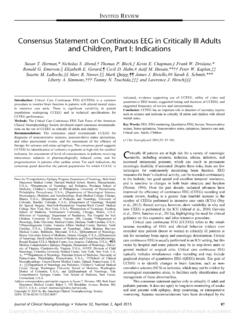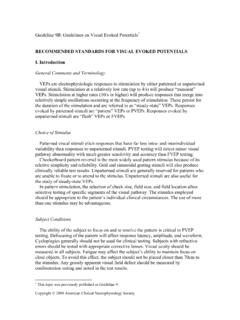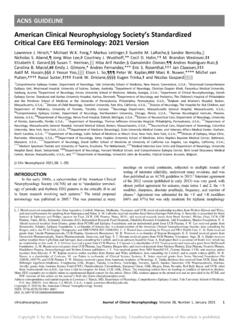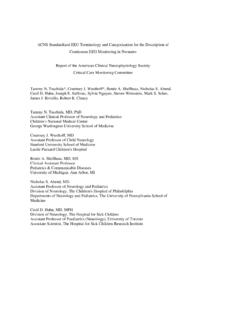Transcription of American Clinical Neurophysiology Society: EEG Guidelines ...
1 GUIDELINEA merican Clinical Neurophysiology society : EEGG uidelines IntroductionTammy N. Tsuchida,* Jayant N. Acharya, Jonathan J. Halford, John D. Kuratani, Saurabh R. Sinha,k Mark M. Stecker,# William O. Tatum, IV,** and Frank W. Drislane *Departments of Neurology and Pediatrics, Children s National Health System, George Washington University School of Medicine, Washington, DC, ; Department of Neurology, Comprehensive Epilepsy Center, Epilepsy Monitoring Unit, Clinical Neurophysiology Lab, Penn State University Hershey MedicalCenter, Hershey, PA, ; Department of Neurology, Medical University of South Carolina, Charleston, SC, ; The Permanente Medical Group, Departmentof Pediatric Neuroscience, Kaiser Permanente Santa Clara, Santa Clara, CA, ;kDepartment of Neurology, Duke University Medical Center, Durham, NC, ; Neurodiagnostic Center, Veterans Affair Medical Center, Durham, NC, ;#Winthrop University Hospital, Mineola, NY.
2 **Department of Neurology,Mayo College of Medicine, Mayo Clinic Florida, Jacksonville, FL, ; and Department of Neurology, Harvard Medical School, Comprehensive Epilepsy Center,Beth Israel Deaconess Medical Center, Boston, MA, :This revision to the EEG Guidelines is an updateincorporating current EEG technology and practice. Standardsof practice in Clinical electroencephalography (previouslyGuideline 4) has been removed. It is currently undergoingrevision through collaboration among multiple medical societiesand will become part of Qualifications and Responsibilities ofPersonnel Performing and Interpreting Clinical NeurophysiologyProcedures. The remaining Guidelines are reordered Words:EEG, Guideline, EEG equipment, EEG electrode, EEGmontage, EEG brain death, EEG report, Adult, Pediatric,Neonatal.
3 (J Clin Neurophysiol 2016;33: 301 302)This revision to the EEG Guidelines is an update incorporatingcurrent EEG technology and practice. Standards of practicein Clinical electroencephalography (previously Guideline 4) hasbeen removed. It is currently undergoing revision throughcollaboration among multiple medical societies and will becomepart of Qualifications and Responsibilities of Personnel Perform-ing and Interpreting Clinical Neurophysiology Procedures. Theremaining Guidelines are reordered and renumbered. A summaryof revisions to each guideline 1: Minimum Technical Requirements forPerforming Clinical EEGD igital equipment has many advantages over analog equip-ment and is now used for EEG in most facilities. Somerecommendations in this guideline have changed to reflect thegreater functionality of digital equipment, including the ability torecord good quality signal with nontraditional electrodes andslightly higher impedances.
4 The list of basic patient informationhas been expanded to include more factors that can influence theEEG. The sections on calibration, sensitivity,filters, andrecording montages have been updated to maintain relevancefor digital systems. Newly added sections include those discus-sing the utility of longer recordings, sleep deprivation, andsimultaneous video recording. Other new sections includematerial on photic stimulation procedure, interpreting physiciannotification of critical EEG results, and data 2: Guidelines for Standard ElectrodePosition NomenclatureThis was previously published as Guideline 5. Although the10-10 system of electrode position nomenclature has beenaccepted internationally for almost two decades, it has not beenused universally.
5 The reasons for this and Clinical scenarios whenthe 10-10 system provides additional localizing information arediscussed in this revision. In addition, section IV elaborates onsituations in which AF1/2, AF5/6, PO1/2, and PO5/6 electrodepositions may be used for EEG 3: A Proposal for Standard Montages tobe Used in Clinical EEGThis was previously published as Guideline 6. A discussionof methodology for the appropriate selection of referenceelectrodes is added. In addition, montages are added to assistwith localization of abnormal activity in mesial frontal andanterior temporal 4: Recording Clinical EEG onDigital MediaThis was previously published as Guideline 8. Recordingparameters have been updated to reflect the higher level of resolutionprovided by current technology.
6 Also, types of storage devices havechanged since the earlier version of this guideline, and recommen-dations are made for digital storage to ensure durability and HealthInsurance Portability and Accountability Act compliant accessibilityas computer technology continues to evolve. Finally, details onthe minimum computer screen display resolution have been 5: Minimum Technical Standards forPediatric EEGThis was previously published as Guideline 2, and, similarto the previous guideline, delineates aspects of Guideline 1 thatAddress correspondence and reprint requests to Tammy N. Tsuchida, MD, PhD,Department of Neurology, Children s National Health System, 111 MichiganAvenue NW, Washington, DC 20010-2970, ; e-mail: 2016 by the American Clinical Neurophysiology SocietyISSN: 0736-0258/16/3304-0301 DOI of Clinical NeurophysiologyVolume 33, Number 4, August 2016301should be modified for neonates and young children.
7 Recordingconditions for photic stimulation and hyperventilation wererevised to enhance provocation of epileptiform were also made to recognize the difficulties involvedin performing an EEG under sedation in young neonatal EEG montages are displayed for thereduced set of electrodes only since the montages in Guideline 3should be used for a 21 electrode 10-20 system array. Neonataldocumentation has also been updated to use current AmericanAcademy of Pediatrics term postmenstrual age rather than conceptual age. Finally, because therapeutic hypothermia altersthe prognostic value of neonatal EEG, it is necessary todocument the patient s temperature at the time of 6: Minimum Technical Standards for EEGR ecording in Suspected Cerebral DeathThis was previously published as Guideline 3.
8 This updatetakes into account more recent publications on brain deathcriteria and artifacts. With modern technology, grounding fromother electrical equipment is no longer a concern, and Guideline1 recommendations to use a ground electrode should befollowed. The 10-10 system electrode positions can be usedwhen equivalent to the recommended 10-20 system settings now reflect digital recording video recording has become available widely andis recommended as a helpful adjunct in cerebral death new section specifies factors that can lead to an inaccuratedetermination of cerebral 7: Guidelines for Writing EEG ReportsThis is a revision of the previous Guideline 7 Writing anEEG Report and is intended to provide an update for routineEEG reporting. The goal is not only to convey clinicallyrelevant information but also to improve interrater reliabilityby standardizing the format of EEG reports.
9 With this goalin mind, there is expanded documentation of the patient historyto include more relevant Clinical information that can affect theEEG recording and interpretation. Recommendations for thetechnical conditions of the recording are also enhanced toinclude post hoc review parameters and type of EEG feature documentation is also expanded upon. Moredescriptive terms are included for background features andinterictal discharges that are concordant with recent efforts tostandardize terminology. In the Clinical correlation section,examples of common Clinical scenarios are provided toencourage uniform reporting. Including digital samples ofabnormal waveforms is now possible and beneficial inaugmenting reports when controversial waveforms or impor-tant features are N.
10 Tsuchida, EEG Guidelines Introduction302 Journal of Clinical NeurophysiologyVolume 33, Number 4, August









